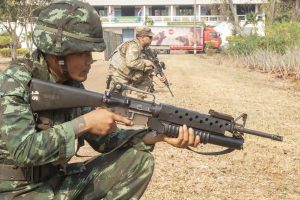Late last month, Thailand’s military announced that it would begin cutting the number of high-ranking officers in its forces. Though the move itself is far from surprising and is in line with previously unsuccessful efforts in this area, it nonetheless spotlights ongoing efforts to address a longstanding concern in the Southeast Asian state.
While Thailand’s military often comes under the most scrutiny for its involvement in politics, that also conceals a series of other concerns that occasionally make the headlines including in its involvement in business as well as its internal recruitment practices. Among these is its bloated, top-heavy nature, with an estimated 1,400 generals across its services and related bureaucracies for about 361,000 active personnel by one count. Previous efforts to address this issue, including cuts to the number of generals serving as experts and changes to the promotion system in the 2000s, have subsequently not been followed through on.
Last month, the issue of personnel reform was in the headlines again with another proposed series of changes. Maj. Gen. Theerapong Pattamasingha Na Ayuthaya, deputy spokesman of the Royal Thai Armed Forces, announced on February 25 that proposed reductions in high-ranking personnel were discussed in a meeting of armed forces leaders chaired by Chief of Defense Forces General Chalermpol Srisawasdi. The proposed measures included disbanding of unnecessary units, reducing the appointments of senior officers from positions as experts and specialists, and delaying establishing new units under high-ranking officers.
The move would not be without significance – if successfully undertaken. Per Theerapong, the new guidelines – part of a broader effort to cut the number of generals by 25 percent by 2029 – would reportedly result in an initial 5 to 10 percent cutback in the number of high-ranking officers, including major generals, rear admirals, and air vice marshals, once the overhaul begins in April. Beyond trimming the number of personnel, the reductions would also have other important effects as well, including in terms of Thailand’s defense budget which has already come under pressure due to COVID-19.
Nonetheless, there have understandably been doubts around whether these proposals can be effectively implemented. Media outlets and opposition politicians have already expressed skepticism that given similar unkept pledges in the past, the current cuts are difficult to believe especially when offered without a definite timeline. It also remains to be seen how the armed forces will manage the ongoing effects of such shifts, including any discontent as well as the redistribution of duties among units and quota adjustments amid personnel reductions.
To get a sense of how this will progress, it will be important to monitor key developments in Thailand’s military over the next few months. This includes reshuffles in personnel toward the end of the year as well as the formulation of the country’s next defense budget, along with the country’s management of COVID-19, its economy, and any changes in government coalition dynamics and the broader political environment.

































